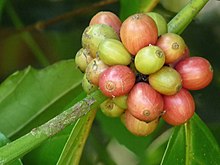Coffea canephora
| Robusta coffee | |
|---|---|
 |
|
| Berries of Coffea canephora | |
| Scientific classification | |
| Kingdom: | Plantae |
| (unranked): | Angiosperms |
| (unranked): | Eudicots |
| (unranked): | Asterids |
| Order: | Gentianales |
| Family: | Rubiaceae |
| Subfamily: | Ixoroideae |
| Tribe: | Coffeeae |
| Genus: | Coffea |
| Species: | C. canephora |
| Binomial name | |
|
Coffea canephora Pierre ex A.Froehner |
|
| Synonyms | |
|
Coffea robusta L.Linden |
|
Coffea robusta L.Linden
Coffea canephora (syn. Coffea robusta), commonly known as robusta coffee, is a species of coffee that has its origins in central and western sub-Saharan Africa. It is a species of flowering plant in the Rubiaceae family. Though widely known as Coffea robusta, the plant is scientifically identified as Coffea canephora, which has two main varieties, robusta and nganda.
The plant has a shallow root system and grows as a robust tree or shrub to about 10 metres. It flowers irregularly, taking about 10–11 months for cherries to ripen, producing oval-shaped beans. The robusta plant has a greater crop yield than that of C. arabica, and contains more caffeine – 2.7% compared to arabica's 1.5%. As it is less susceptible to pests and disease, robusta needs much less herbicide and pesticide than arabica.
Originating in upland forests in Ethiopia, C. canephora grows indigenously in Western and Central Africa from Liberia to Tanzania and south to Angola. It was not recognized as a species of Coffea until 1897, over a hundred years after Coffea arabica. It is also reportedly naturalized in Borneo, French Polynesia, Costa Rica, Nicaragua, Jamaica and the Lesser Antilles.
Approximately 30% of the coffee produced in the world is robusta. It is mostly grown in Vietnam, where French colonists introduced it in the late 19th century, though it is also grown in Africa and Brazil, where it is often called conilon. In recent years, Vietnam, which produces mostly robusta, has surpassed Brazil, India, and Indonesia to become the world's single largest exporter of robusta coffee. Brazil is still the biggest producer of coffee in the world, producing one-third of the world's coffee, though 80% of that is C. arabica.
...
Wikipedia
